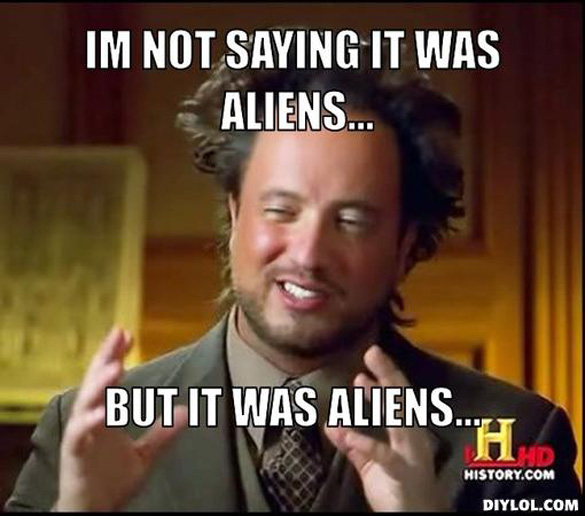
| Author | Message |
What Killed the Dinosaurs? Science Has Had Some Wild Ideas What Killed the Dinosaurs?Science Has Had Some Wild IdeasBefore Chicxulub, people had some odd theories about what caused the demise of the dinos, including low libido and caterpillars run amok.

Earlier this month on the Gulf coast of Mexico, an international team began drilling into a vast scar on Earth’s surface. The enormous pockmark, which stretches 110 miles (177 kilometers) wide, was created when a chunk of space rock slammed into the planet about 66 million years ago. The cosmic smashup isn’t even one of the top five largest hits in Earth’s history, but it holds a special place in our imaginations. That’s because the site, known as the Chicxulub crater, was ground zero for the mass extinction that brought the age of dinosaurs to a close. . While the giant impact is the most likely weapon in this ancient murder case, we know surprisingly little about how the strike translated into widespread death and destruction. Paleontologists have debated aspects of the impact’s ecological fallout ranging from blazing wildfires to an impenetrable cloud of debris in the atmosphere. . But exactly what happened and how such environmental shocks would have killed some species while sparing others is still up for debate. . That’s part of what the crater drilling team hopes to figure out—and it’s just the latest effort in a long history of research trying to figure out what happened to the world’s “terrible lizards.” . Cataracts to Caterpillars . When the first dinosaur fossils were described in the early 19th century, paleontologists saw them as just another group of animals slowly lost to time. Species evolved and went extinct as life shuffled on through the ages. . By the 1920s, however, enough fossils had turned up that scientists began to wonder how so many of the animals had vanished so completely. Aschronicled by University of Bristol paleontologist Michael Benton, the scientific literature of the time saw a dramatic spike in the number of published papers proposing dino death theories. . Not that the interest was all academically sound. This was a boom time for crazy conjectures about the catastrophe, and seemingly everyone who had a wild idea about what killed the dinosaurs spouted off about it. . The far-fetched ideas didn’t stop there. Slipped discs, out-of-control hormones, low sex drives, disease, cataracts, and even just plain dino stupidity were all implicated. . In 1962, one entomologist even suggested that ancient Earth was overrun by caterpillars, and the insects ate so much plant life that there was nothing left for the dinosaurs. The resulting ecological crash saw butterflies flitting over the starved bodies of dead Triceratops. Nevermind how caterpillars would have driven species to extinction in the skies or the seas. . Space Metal . The puzzle wasn’t just about the dinosaurs, though. By the 1970s paleontologists could see that a real, mysterious event had affected a great proportion of life on Earth. One estimate puts the death toll at 75 percent of known fossil species, from the total loss of pterosaurs in the skies to the end of coil-shelled ammonites in the seas. The period is also marked by severe reductions in the numbers of ancient birds, lizards, and mammals. . But even with the mounting evidence, no one had any solid, serious idea for what caused the turmoil. . Then in 1980, geologist Walter Alvarez and his colleagues proposed something dramatically different. The rock layer marking the end of the Cretaceous period was rich in iridium, a metal that is rare in Earth’s crust but more common in meteorites and asteroids. Could the dinosaurs and other forms of life have been killed off by a shock from space? . While the concept spurred years of debate, over time it has become the favored theory for the dinosaurs’ demise. The 1991 discovery of the Chicxulub crater off Mexico’s Yucatán Peninsula provided the smoking gun. Research since then has only further implicated the ancient asteroid. In 2010, a group of 41 researchers published a position paper in Scienceasserting that the impact was the most important factor in tipping the world into its fifth mass extinction. Hunt for Triggers . Not that debate has ceased. Even now, a handful of experts prefer the idea that massive volcanic eruptions in India, changing sea levels, and other causes were more important for the extinction event. . To help bring more resolution to the dinosaur’s apocalyptic moment, the new drilling project aims to draw up cores from various levels of the crater between now and June. In addition to providing new geologic details about how impact craters form, the researchers hope to scrape up new information about the triggers for the sweeping environmental changes, as well as how life recovered once the worst was over.
"Music gives a soul to the universe, wings to the mind, flight to the imagination and life to everything." --Plato
https://youtu.be/CVwv9LZMah0 | |
- E-mail - orgNote -  Report post to moderator Report post to moderator |
| |
- E-mail - orgNote -  Report post to moderator Report post to moderator |
| |
- E-mail - orgNote -  Report post to moderator Report post to moderator |
. unless the dinosaurs were the aliens! | |
- E-mail - orgNote -  Report post to moderator Report post to moderator |
 New topic
New topic Printable
Printable